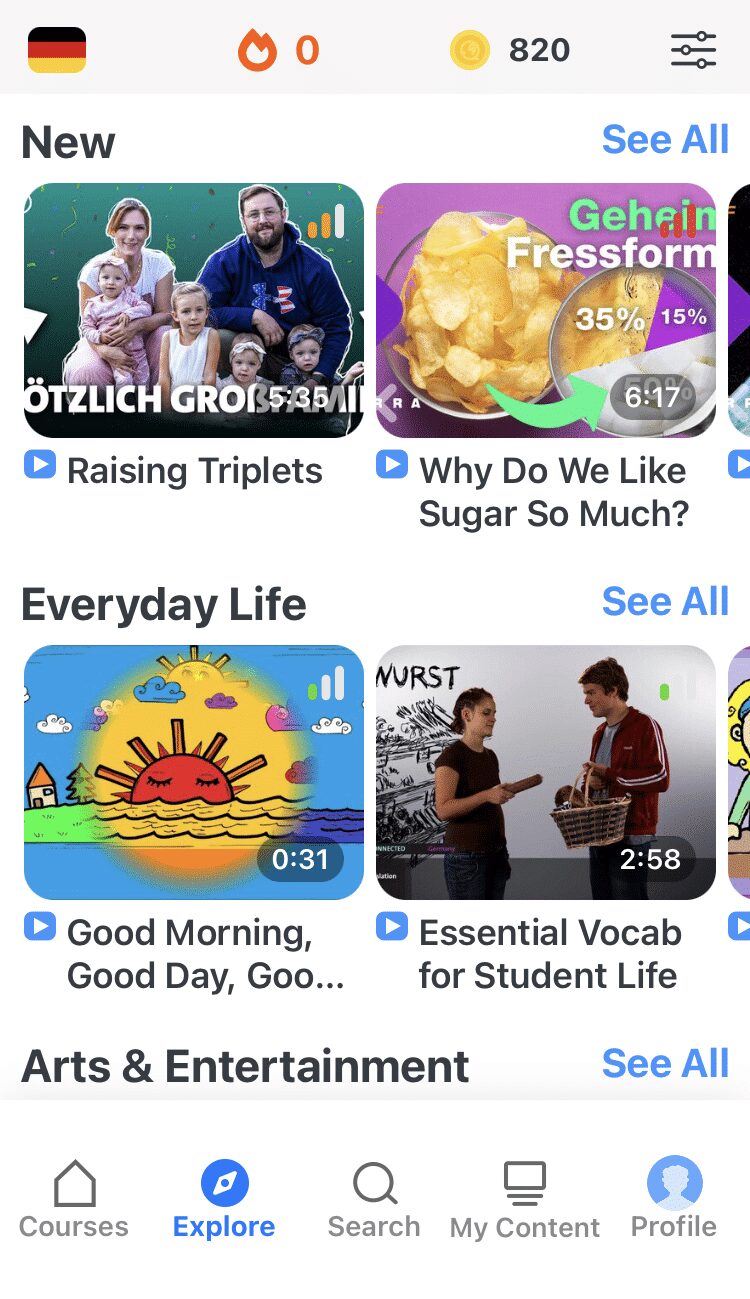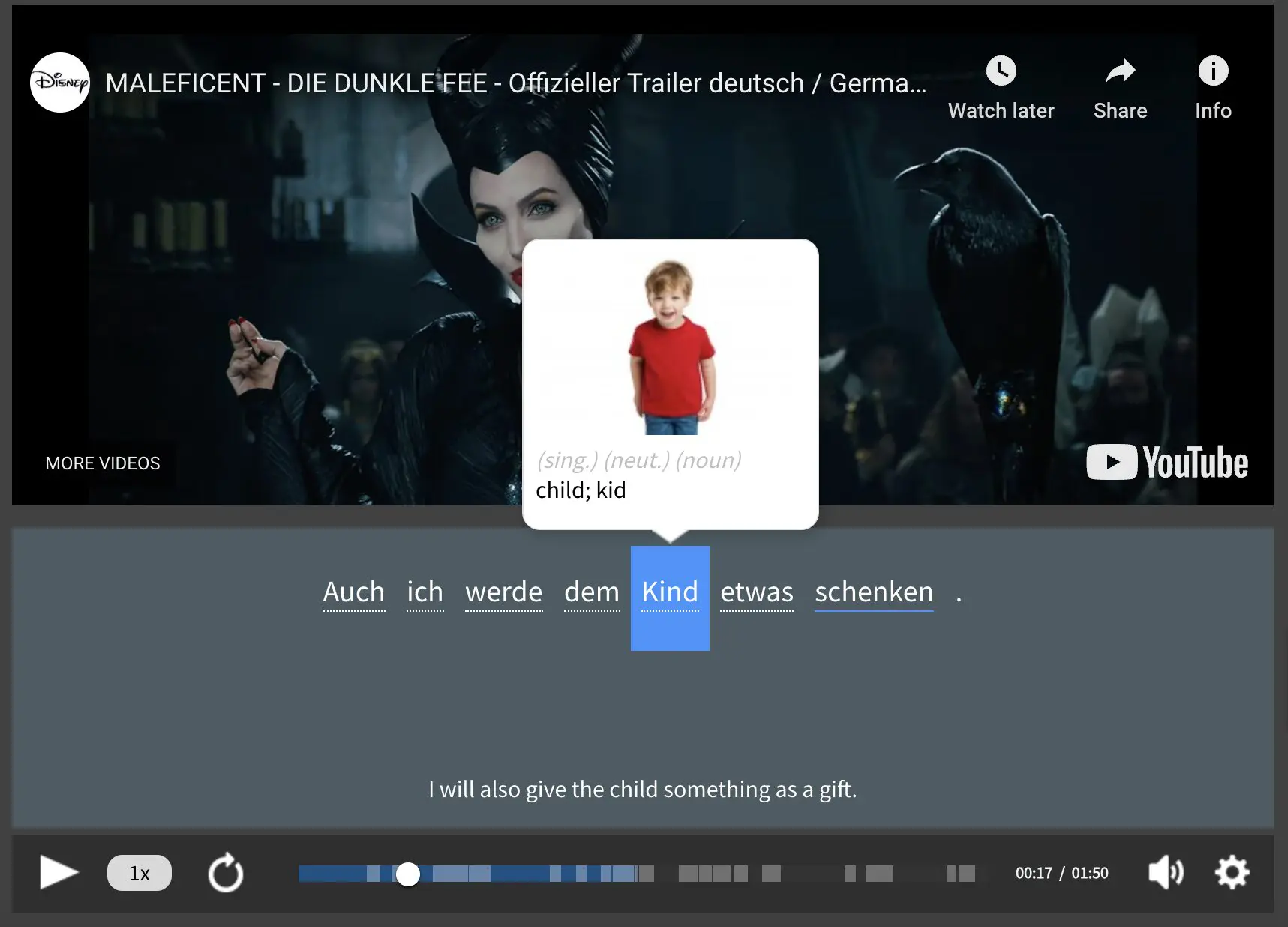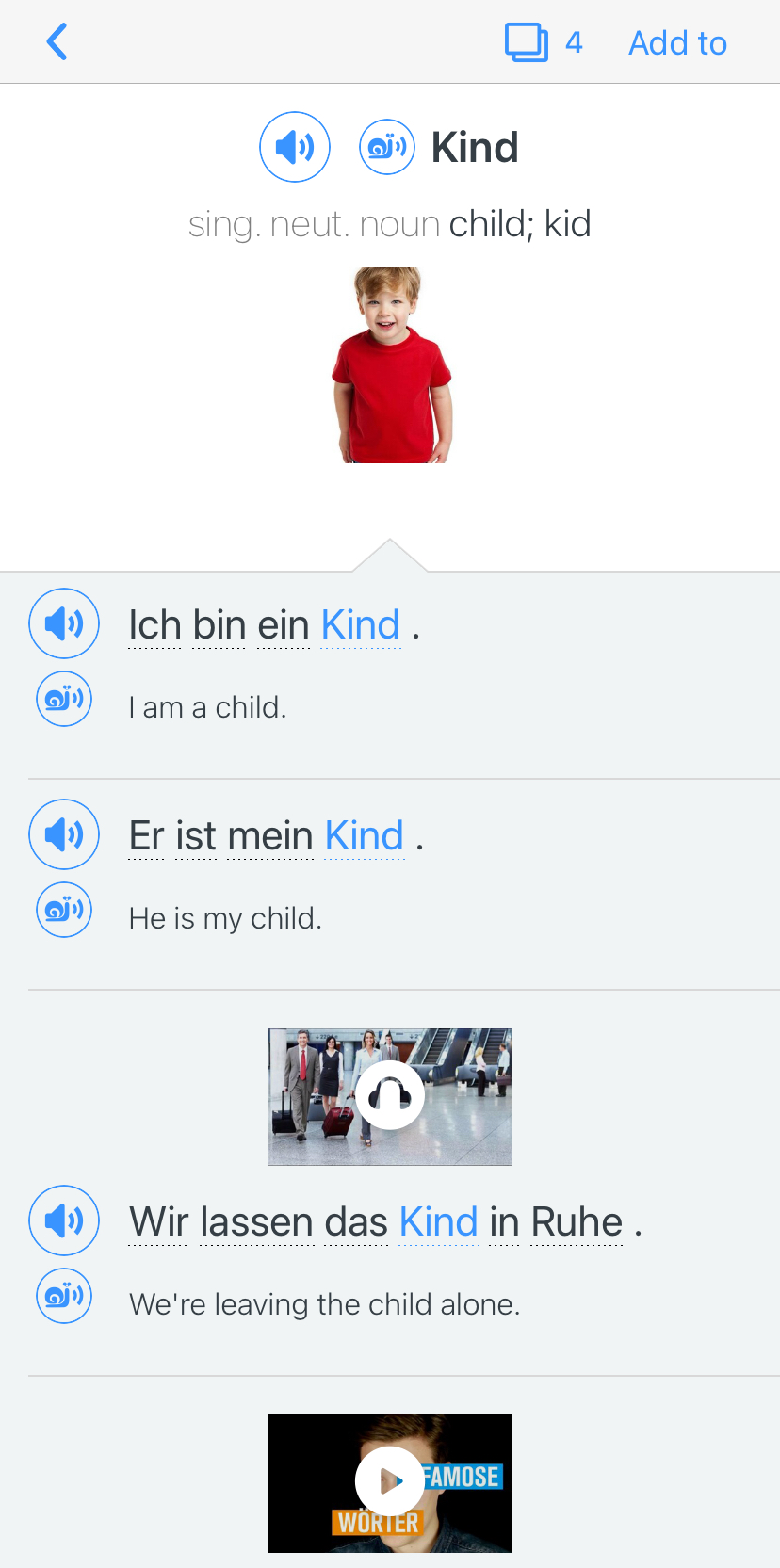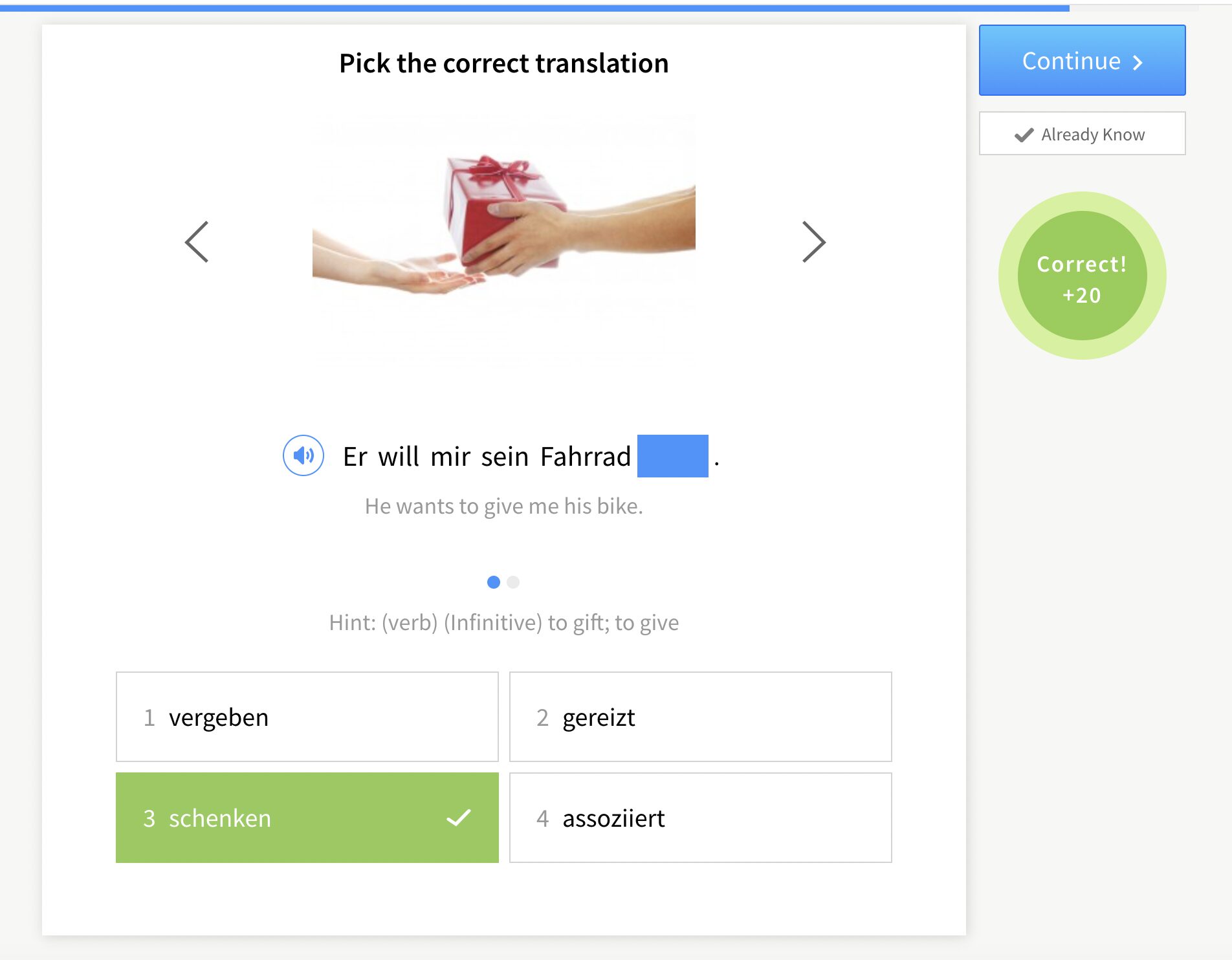How to Learn German Fast

The best way to learn German is by practicing efficiently and intelligently—not just studying a lot.
That’s exactly what we’ll show you in this article: how to learn German in 10 speedy steps that you can build on and start using the language sooner.
Download: This blog post is available as a convenient and portable PDF that you can take anywhere. Click here to get a copy. (Download)
10 Steps to Learn German Fast
1. Use Word Frequency Lists to Learn the Most Useful German Vocabulary
Especially in the beginning, learning and practicing vocabulary is the main part of language acquisition. There’s no way around it. However, not all words are created equal. It’s important to concentrate on words that’ll give you the most bang for your buck.
In terms of language learning, the most bang means how likely it is that you’re going to use a particular word in everyday conversation. That’s where word frequency lists come in.
You don’t need to learn all that much for functional fluency. The 1,000 most common words in German make up about 80% of the written language. So if you concentrate on those first, you’ll make a big dent in the amount of German you’ll be able to understand. It’s the easiest way to learn basic German words that you’ll actually need in real life.
Frequency lists for all kinds of languages can be found on the internet easily. A good starting place is Wiktionary, but you’ll find more with the help of your search engine of choice. You can also find the 200 most common German nouns right here.
One great way to collect high-frequency vocabulary is to learn with videos that show everyday situations in German.
For pure memorization, I can also recommend the flashcard software Anki. It offers spaced repetition which means that instead of studying the same words in the same order every time, Anki will show them to you at strategically spaced intervals. That way they move into your long-term memory. It also tracks the number of words you already know.
2. Learn Modal Verbs: Say More with Fewer Conjugations
Let’s face it, one of the most tedious things about German is the number of declensions and conjugations. Verbs change form according to case and tense as well as grammatical person and number. Say what?!
Learning all forms for every verb can be exhausting, especially for the dreaded imperfect or simple past. How about instead you learn to conjugate just seven words that’ll let you express almost everything you need? Sounds better, right?
I’m talking about modal verbs, more specifically, these seven:
These modal verbs, when used in a sentence, take the position of the verb. The other verb, in turn, moves to the end of the sentence in the infinitive.
As a formula it looks a little like this:
Subject + Verb + Object → Subject + Modal Verb + Object + Verb (infinitive)
How is that helpful to learning German fast? Because it allows you to use all kinds of verbs in a great number of sentences without knowing how to conjugate each and every one of them. As long as you memorized how to conjugate the modal verbs, all you need is the infinitive form. Compare these two sentences:
Ich gehe nach Hause. (I am going home.)
Ich will nach Hause gehen. (I want to go home.)
In the first, gehen is conjugated, but in the second gehen is in the infinitive. The two sentences aren’t exactly the same, but the intention is certainly clear and any native German speaker will understand what you mean.
3. Make a German-speaking Friend for Constant Speaking Practice
Learning German online and by yourself can be a little isolating, and it can be hard to find someone to get direction from or to speak German with if you’re not enrolled in a German course.
What’s the solution?
You need to make a German-speaking friend, of course!
Meeting a German-speaking friend is crucial for you to practice speaking and understanding the German language. Rather than just passively absorbing the language by doing things such as reading in German or listening to German, having a German-speaking friend forces you to use the language actively.
You have to understand and respond—either verbally or in written form—to whatever you and your German-speaking friend are discussing.
Best of all, some German-speaking friends may even give you tips for pronunciation and offer to teach you a bit of vocabulary and grammar. They may even teach you some informal language and slang, which is important if you want to learn the German that’s actually spoken by everyday speakers.
German-speaking friends can be found online, and it’s free. In fact, you can meet a German-speaking friend by connecting on a language-learning website such as italki.
Simply search for native German speakers in the “Language Partners” part of the website, and you’ll encounter many other language learners who will speak to you in German if you speak to them in a language you know.
Once you’ve met a German-speaking friend on a site like italki, you could then practice on Skype or a social media platform. This practice should happen verbally. Speaking is often the skill that’s overlooked for online German learners, so don’t worry about mistakes and get chatting!
In addition to language exchange websites, you may even meet German-speaking friends or other German learners by joining a German conversation group in person. Such groups can be found by looking on a local or online bulletin board as well as on websites like Meetup. Simply search for German conversation events or other German cultural events and find one in your city.
4. Learn German Syntax: Make Sure Every Word Has Its Place
Word order, or “syntax” as it’s known linguistically, is the sequence in which words must be placed in order to have a sentence make sense.
In English, for example, we know that most sentences have a subject (the doer), a verb (the action) and an object (the thing acted on by the verb). Take the English sentence, “the dog ate the bone,” for example. “The dog” is the subject, “ate” is the verb and “the bone” is the object,
German, however, often has sentences with word orders that are different from English, and if you do word order in German wrong, you risk not being understood.
The golden rule of German word order is: in simple sentences, the verb comes second. This is usually the case in English too, but German is far stricter!
An example of differing word order might be, if there’s a phrase in the “first position” (at the beginning of the sentence), the verb must go in the second position and the subject (the “doer”) follows.
This happens in the sentence, jetzt habe ich einen Hund. While the meaning of this sentence is, “now I have a dog,” the literal translation is, “now have I a dog.”
This is because the verb is anchored in the second position of the sentence. If another word (in this case, jetzt ) is in the first position, the subject ( ich ) has to come after the verb habe (have).
Another example is sentences with auxiliary verbs or modal verbs. This occurs most often in the future or past tenses or in cases with two verbs in one sentence. In these cases, the auxiliary or modal verb occupies the second position in the sentence and the main verb goes to the end of the sentence.
Take the sentence, ich muss meine Hausaufgaben machen (I have to do my homework). In this case, there are two verbs: muss (must) and machen (do).
In English, one verb would naturally follow the other, but in German, that second verb ( machen ) has to go all the way to the end of the sentence.
Making a question also changes the word order in German. In this case, the subject and the verb simply change positions. For example, to say, “do you know my mom?” you say, kennst du meine Mutter? The verb kennst (know) and the subject du (you) have swapped spots to form a question.
These are just some examples of word order differences in German. To attain even the most basic German conversational skill, you need to understand syntax. Lucky for you, there are many places to practice these orders for free online.
I recommend ToLearnGerman or Instruct.uwo.ca.
5. Learn German with Authentic Materials
Real-life German materials are important for learning German. They allow you to hear German as it’s actually spoken, including all of its pronunciation, grammar and the times when native speakers use informal language, slang and break the traditional grammar rules.
In fact, learning German with materials that feature real German speakers and real spoken German improves your understanding of the language, your pronunciation and your ability to produce spoken and written German with ease.
Lucky for you, you don’t need to move to a German-speaking place to get spoken German. Authentic German content can be found all over the internet, and you can, in fact, learn German there for free!
For access to real-world spoken German on the internet, I suggest you watch vlogs or other videos on YouTube. My favorites include the countless channels that help you master German as well as channels that entertain while you learn.
I also recommend watching German videos with subtitles. In fact, short of a German-speaking language partner, watching videos in authentic German with subtitles and exercises to reinforce what you’ve learned is one of the best ways to master German.
German Immersion from Your Device
I get it–learning German isn’t always a walk in the park. But it doesn’t have to be a boring, tedious, or hair-pulling experience either. In fact, making it fun is key to your success!
With FluentU, you can learn German naturally by turning any YouTube or Netflix video with subtitles into an interactive language lesson. I’m talking about language immersion from the convenience of your device.
You can even import your favorite YouTube videos into your FluentU account to learn from them using the app or website. Or browse our curated library of videos handpicked for beginners and intermediate learners.
While you watch a video, FluentU’s interactive subtitles let you tap on any word for an instant definition, example sentences, images, and audio. No more pausing and searching for translations—everything you need is right there!
It's all built to help you learn how to use words in real contexts. And as you learn, you can add new words to your flaschards with just a click! For example, if I tap on the word "Kind," this is what pops up:
Learn even faster with built-in quizzes that reinforce vocab from every video. FluentU tracks your progress, gives you extra practice with tricky words, and reminds you when it’s time to review—so your learning is always personalized and effective.
Try FluentU today on your computer or tablet, or download our app from the App Store or Google Play. Click here to take advantage of our current sale! (Expires at the end of this month.)
Lastly, for access to real-world written German, I recommend you read blog posts in German or use social media in German.
6. Learn German Prepositions with their Cases
German grammar is one of the trickiest aspects of the German language. One aspect, in particular, takes the cake as the most complicated: grammatical cases in German.
In German, the placement of a word in a sentence dictates what case it’s in. That means that a word’s definite or indefinite article changes whether the word is the subject, the direct object or the indirect object.
Further, if the noun is an object of a preposition, this also changes the case of that noun. However, not all prepositions are followed by the same case: each preposition is followed by a different case and a different set of declination rules entirely
This means that memorizing the case with the preposition is a great way to save time and ensure you’re using the correct case with the following noun.
The following prepositions have the accusative case used in the nouns that follow them:
| Preposition | Meaning |
| für | for |
| gegen | against |
| um | around |
| durch | through |
| ohne | without |
| bis | until |
|
entlang (usually comes after the noun) | along |
The following prepositions have the dative case used in nouns that follow them:
| Preposition | Meaning |
| after/to | |
| seit | since/for |
| aus | out of, from |
| bei | at/during |
| zu | to, at |
| von | from, of |
| mit | with |
| außer | except, apart from |
Some prepositions are “two-way prepositions.” This means that they can use the accusative case or the dative case depending on the sentence’s intended meaning:
| Preposition | Meaning |
| vor | in front of |
| hinter | behind |
| zwischen | between |
| an | on/at |
| in | in |
| auf | on/in |
| über | over |
| unter | under |
| neben | next to |
Two-way prepositions use the accusative when talking about a change of position, and they use the dative when they talk about a position that is unchanging.
Take the sentence, ich gehe in den Laden (I go to the store), for example. Here, the verb gehen (go) indicates there’s a change of position, so the noun that follows the preposition in has to be in the accusative. That’s why we get den Laden (the store).
However, in the sentence, ich bin im Laden (I am in the store), the word bin indicates no change of position. Therefore, Laden must be in the dative, which is why we get dem, then going to im. (in + dem becomes im)
7. Strong & Weak: Learn Regular and Irregular German Verb Forms
As in English, German has two types of verbs. They’re referred to as strong verbs and weak verbs.
Weak verbs are regular verbs. This means that they follow regular, predictable rules for the present and past tense in German.
Strong verbs, on the other hand, are irregular and don’t follow the regular, predictable rules for conjugation.
This means that strong verb forms must be memorized separately in order to be used correctly. You should try to memorize these irregular forms when you encounter a strong verb.
Lucky for you, the “irregularities” in strong verbs are generally simple changes in spelling and in pronunciation. For example, we can look at the German verb laufen (to run).
We know that weak verbs (or regular verbs) remove the -en ending and add a t when conjugating with the er, sie or es (he, she or it) subjects. Laufen, however, take this a step further. In addition to its t, the a of the verb also gets an umlaut on it to get läuft . This changes the pronunciation of the word, and this irregularity also happens with the du subject to get du läufst (you run).
8. Use German Culture to Learn the Language
Despite being a single language, German has many dialects depending on where it’s spoken. That means that the German spoken in Berlin is different from the German spoken and Munich, and those dialects are different from the German spoken in Hamburg.
Further, the German spoken in Austria and Switzerland is also very different from the varieties of German spoken in Germany.
Sometimes these differences can make it feel like you’re learning several completely different languages.
This can quickly make things very confusing for German learners.
While it’s most useful to learn Hochdeutsch (High German), or the Standard German often taught online, in classes and in textbooks, you should learn a little bit about the German of any place you plan to visit.
This means looking at samples of the language online, perhaps in videos, or reading about it, so that you know what particularities there are in that particular dialect.
While you’re at it, you should learn German slang.
Slang is something used in all dialects of German, and while some slang might be universal, each dialect may also have its own slang words and phases.
Lastly, it’s also useful to learn some German history. History is often responsible for the way that many things are said or even why things are called what they’re called, so by brushing up on some history of the German-speaking world, you can even improve your German language skills!
9. Practice Nouns and Genders at the Same Time
Something that doesn’t come easy to many students of German is the fact that the language includes three genders for its nouns: masculine, feminine and neuter. These genders are represented by the definite articles der, die and das, and the indefinite articles ein, eine and ein.
This is further complicated by the fact that there are no clear-cut rules for which gender is assigned to which kind of noun, and if there appear to be any there is always an exception.
For instance, “der Mann” and “die Frau” make sense because “the man” and “the woman” are male and female, respectively.
However, why is it “der Junge” (the boy) but “das Mädchen” (the girl)?
The whole thing seems to be based more on convention than anything else and is something that Germans just grow up with. How can you ever learn German with all of these crazy grammatical genders to memorize?
Instead of shaking your fist at the sky and cursing the Teutonic gods for unleashing this linguistic plague on the rest of mankind, I’d advise you to embrace it.
The easiest and fastest way to learn German genders is to treat the gender of a noun as an integral part of the word right from the beginning. Instead of merely learning “Haus” , learn “das Haus,” a hand isn’t merely “Hand” but “die Hand.”
A little trick to make this easier and quicker is to get flashcards in several colors and assign a color to a gender. For example, green could be masculine, red for feminine and blue for neuter.
When studying vocabulary, write down each noun on a card in the color assigned to its gender. This will provide you with a visual cue to help you remember the word’s gender more easily.
The color coding can be further enhanced by a mnemonic technique: when you learn a noun, picture the thing it describes in your head and establish a mental connection to the color of the grammatical gender.
For example, you can think of a green dog to remember “der Hund” , or imagine red Santa pants to remind yourself that it’s “die Hose” .
Do this consistently and you’ll be a master of German gender in no time.
10. Learn Cognates: Harness the Words You Already Know
Languages don’t evolve in complete isolation. They mix in the same way as the people who speak them and are as intertwined as family trees. Everyone borrows from everyone else and German is no exception.
This is good news if you want to learn German fast because of cognates. Cognates are words in two different languages whose spelling and meaning are so similar that they’re easily recognized and understood.
These familiars make it impossible to start entirely “from scratch” with a language because there are tons of words already at your disposal.
I remember being completely surprised at my ability to read 80% of everything that was written inside a supermarket in Barcelona—without ever having taken a single Spanish lesson in my life.
It was all thanks to the fact that Spanish is a Romance language, and I took four years of Latin in high school. True story.
The good news for English speakers is that there are many thousands of German words that are cognates of English words. The two languages have a lot of common roots.
For example:
- “water” becomes Wasser (t → s after a vowel)
- “chin” becomes Kinn (ch → k)
- “father” becomes Vater (th → t)
Easy, right?
If you really want to nerd your way into it, take a look at the rules of the High German Consonant Shift and it’ll all make a lot more sense. But even without, it’s easy to see the common history of the two languages.
Here’s a list of important German-English cognates you can use for some fast vocabulary building right away.
How Long Does It Take to Learn German?
Now that you’ve decided to learn German, the next natural question is, “how long will it be until I get fluent?”
The answer to this question depends on two things.
The first is how you measure fluency. Does fluency to you mean that you can understand 95% of what you hear and respond appropriately? Does it mean knowing enough to live or work in a German-speaking city? Or does fluency mean you can understand German newspapers and classic books? Your definition of fluency may change how long it takes to reach the level you desire.
Secondly, how long it takes to learn German online depends on how much time you can dedicate to learning German.
For example, if you keep a regular schedule with many hours of study a week, you’ll reach levels faster than only studying a couple of hours a month. In fact, the amount of hours studying generally increases your fluency in German.
Therefore, if you study regularly, you can study many hours in a shorter amount of time and learn German faster than learning sporadically.
So, how many hours do you need?
Well, according to the Goethe Institut (Goethe Institute), the following amounts of hours are needed for each language level:
- A1 (Survival German): 60 – 150 hours.
- A2 (Basic German): 150 – 260 hours.
- B1 (Conversational German): 260 – 490 hours.
- B2 (High Intermediate German): 450 – 600 hours.
- C1 (Advanced German): 600 – 750 hours.
- C2 (Near Native Fluency): 750+ hours.
In terms of fluency, one is generally thought to be “fluent” at around the C1 level. This, of course, depends on your definition of fluency.
Keep in mind also that this isn’t a perfect scale. Some may learn faster than others, and some may need many more hours depending on the method they use to study German. For example, online and offline immersion is more effective than textbook memorization.
And those are our tips to learn German fast! The above shortcuts for how to learn German will get you actually speaking in no time. That’s when the real fun begins.











